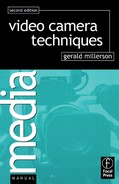When you stop and analyze the range of regular shots you can take of a pianist at the piano, you will find that they are relatively limited. Of course, there are those various ‘novelty’ approaches – looking at reflections, silhouettes, and shadows. There are the ‘unusual angles’, and also those trick shots, in which pianists play duets with themselves or appear in multi-view segmented pictures. But unusual treatments have a nasty habit of drawing attention to their own cleverness, and away from the performer and the music itself.
A piano can be a challenging instrument to shoot attractively, for its large mass only frames successfully from certain directions. From other angles, the keyboard can’t be seen – or even the pianist!
On the opposite page you can see typical shots a piano offers. Most effective views of the keyboard are shot from the right hand (treble) end, and put the pianist to the left of the picture. Shooting from the bass end of the keyboard, shots are rather restricted, for they do not intercut well with other viewpoints. There is always the danger of reverse cuts.
At normal camera heights, moving around the piano is confined to a rather limited arc, as the pianist’s back, the piano lid or the body of the piano obscure the shot.
For close-ups of fingerwork, narrower lens angles are the obvious solution. However, depth is usually so shallow, that it may not be possible to follow focus on a fast-moving hand. Restricted depth, together with severe foreshortening of the keyboard, can make such detailed shots unpredictable.
Camera moves are generally keyed to the pace and mood of the music. Rapid shot changes from a variety of positions may be great for a pop group, but unless the director is prepared to have cameras in shot, operations can become too hectic to sustain. For a quiet passage during a recital of classical music, camera moves must often be so slow that they are almost imperceptible. The audience is not aware of the change, but they respond to the effect; the blend of sound and picture producing an emotional whole.
Shooting the pianist
When presenting a piano performance, the basic range of attractive shots is relatively limited.

